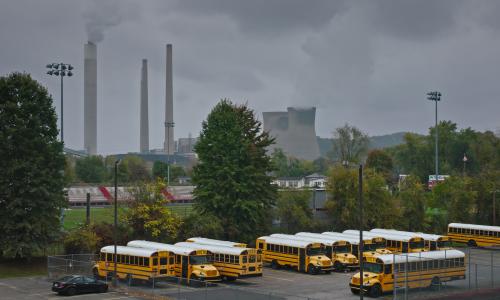Electricity. It's essential to our modern way of life, from the phone in your pocket to the lights overhead. And yet right now we are relying on a dirty, outdated electricity system to deliver us the power we need. Our country's electricity infrastructure is simply not keeping up with the times.
It's time for an upgrade—to a better, cleaner, and more reliable electricity grid.
Upgrading the grid
The electricity grid transmits power generated at a variety of locations and distributes it to end users—like you!—often over long distances. It provides electricity to buildings, industrial facilities, schools, and homes. And it does so every minute of every day, year-round. Learn more about how the electricity grid works.
But there's a problem. Our current grid was built decades ago and was designed primarily for transmitting electricity from large, centralized power plants, most of which use dirty sources like coal and natural gas. Now new technologies are making this approach to electricity transmission—and its supporting infrastructure—increasingly outdated.
Today power flows from many more sources—including rooftop solar, wind power, and battery storage—and the grid needs to catch up to the progress we've made.
This is especially crucial as renewable energy continues to boom and solar and wind power grow rapidly across the country. If we don’t upgrade our systems now, we run the risk of over-relying on natural gas rather than taking advantage of renewable energy sources that meet our needs with cleaner, more reliable electricity.
To ensure that momentum continues toward renewable energy—and to set the stage for even higher levels of renewable energy in the future—we must modernize the electricity grid.
It's an essential part of our growing efforts to reduce global warming emissions, clean our air, and prepare for the growing consequences of climate change.
A flexible, modern system
We have the technology and know-how to build an electricity grid that will reduce harmful pollution, keep the lights on when storms strike, and benefit customers, utilities, and electricity generators alike.
A modernized grid is flexible enough to manage the variability of wind and solar resources, and to connect sources of high renewable generation potential—like windy and sunny areas—to locations of high energy demand, like population and industry centers.
A flexible, modern system must also be able to accommodate more local sources of power—like rooftop solar and battery storage—and increasing numbers of electric vehicles.
Learn more about why electric cars and trucks are part of our clean energy future.
Smart appliances and electricity pricing systems will help people use electricity at times when they can save money and at times that are best for renewable energy generation.
Learn more about how time-varying rates are part of a modern electricity management system.
Upgrading our electricity grid will also help ensure that people and businesses have power when they need it most. Widespread blackouts can occur even when only a few components of the electricity grid succumb to extreme weather—and right now power plants, substations, and other electricity infrastructure all across the country are at risk from coastal flooding, wildfires, and other weather events.
Ensuring reliable electricity requires us to adapt to these growing risks and to make needed investments in an electricity grid that plans for the conditions of both today and well into the future.
It just makes sense. It's time to upgrade our electricity grid for the needs of today... and for a better, cleaner tomorrow.



